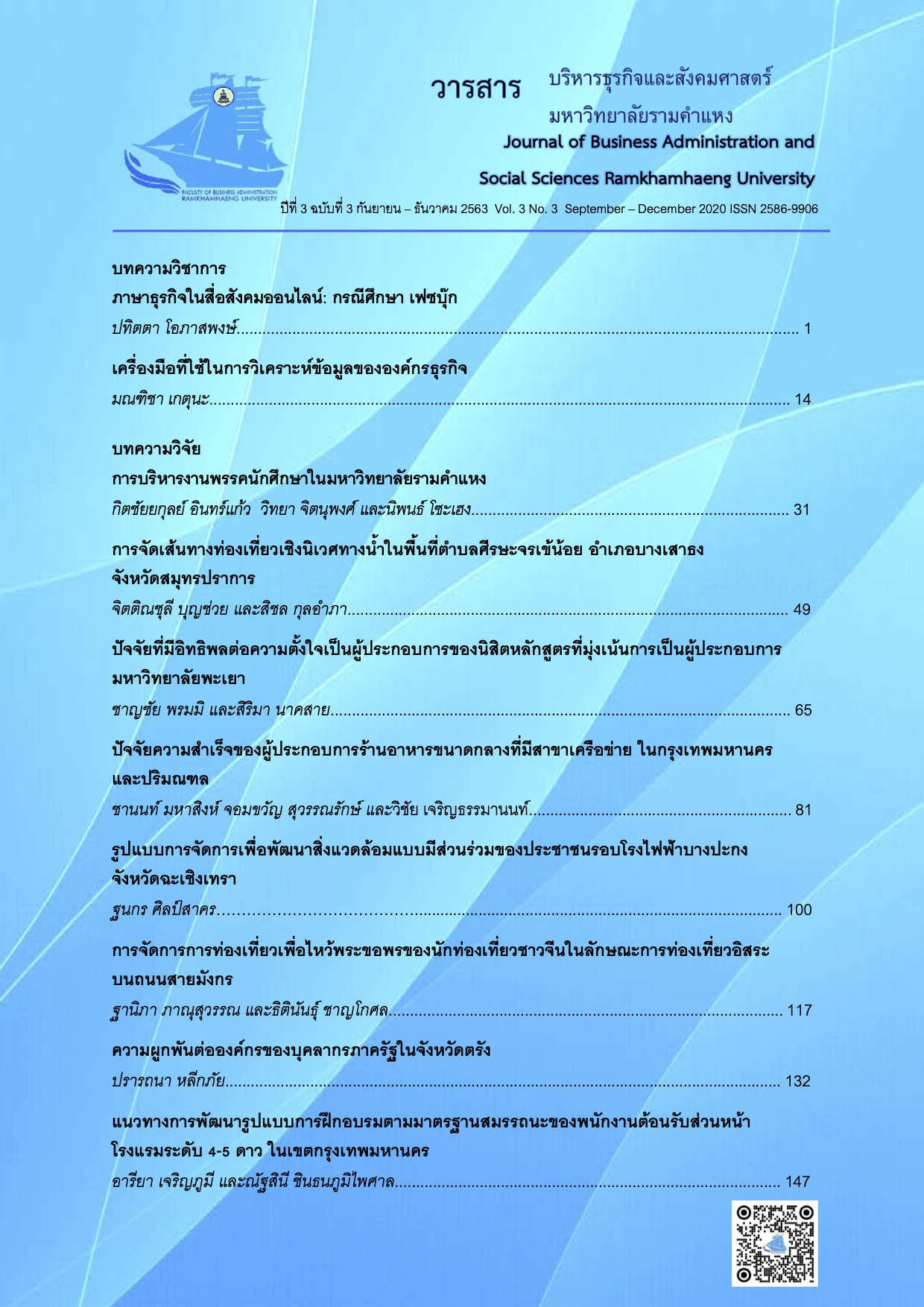Business Language in Social Media: A Case Study of Facebook
Main Article Content
Abstract
In this article, the study is on the use of business language in social media with the focus on the business language used in Facebook, the social media with the highest number of users, to determine the characteristics that enhance business to become successful in social media. Findings show that the business language used in the social media, Facebook, is concise, short, clear, and easy to understand in order to attract attention. Corrupted words or young persons’ language that has changed in accordance with social context have been used for modernity. This may result in persuasion to purchase products or services immediately. Business should use non-verbal language instead of verbal language. Some examples are the use of pictures, symbols, or product logos for communication. In addition, the use of Thai should be recommended to be accurate and appropriate. This is to avoid cases where communication uses corrupted language or the slangs young persons tend to use nowadays.
Article Details
เนื้อหาและข้อมูลในบทความที่ลงตีพิมพ์ในวารสารบริหารธุรกิจและสังคมศาสตร์ มหาวิทยาลัยรามคำแหง ถือเป็นข้อคิดเห็นและความรับผิดชอบของผู้เขียนบทความโดยตรง ซึ่งกองบรรณาธิการไม่จำเป็นต้องเห็นด้วย หรือร่วมรับผิดชอบใดๆ
บทความ ข้อมูล เนื้อหา รูปภาพ ฯลฯ ที่ได้รับการตีพิมพ์ในวารสารบริหารธุรกิจและสังคมศาสตร์ มหาวิทยาลัยรามคำแหง ถือเป็นลิขสิทธิ์ของวารสารบริหารธุรกิจและสังคมศาสตร์ มหาวิทยาลัยรามคำแหง หากบุคคลหรือหน่วยงานใดต้องการนำบทความทั้งหมดหรือส่วนหนึ่งส่วนใดไปเผยแพร่ต่อ หรือเพื่อกระทำการใดๆ จะต้องได้รับอนุญาตเป็นลายลักษณ์อักษรจากวารสารบริหารธุรกิจและสังคมศาสตร์ มหาวิทยาลัยรามคำแหง ก่อนเท่านั้น
References
จตุพร แจ่มชุมศิลป์. (2547). การสร้างความหมายและแรงจูงใจให้มีสิทธิผลต่อการสื่อความหมายของสื่อโฆษณาสิ่งพิมพ์เพื่อการอนุรักษ์พลังงาน โครงการพลังงานไทยลดใช้พลังงาน. กรุงเทพฯ: มหาวิทยาลัยธรรมศาสตร์.
ปณชัย อารีเพิ่มพร, (2561). สถิติเฟซบุ๊กไทยที่พ่อค้าแม่ค้าออนไลน์ควรรู้. สืบค้นเมื่อ 20 ตุลาคม 2563 จาก https://www.Thestandard.co/facebook-Thailand-statistic
ปิยะ วราบุญทวีสุข. (2553). สังคมออนไลน์กับการทำธุรกิจ: แนวทางการทำการตลาด. Executive Journal, 30(2), 181-185.
พัลลภา ปิติสันต์. (2556). “Nowism” ผู้บริโภคยุคใหม่ไม่ชอบรอ. For Quality Marketing& Brand, 20(194), 64-66.
ลงทุนแมน. (2561). ผู้ร่วมก่อตั้งFacebookมีใครบ้าง? สืบค้นเมื่อ 2 พฤศจิกายน 2563 จาก https://www. longtunman.com/6268
วิทยา ดำรงเกียรติศักดิ์. (2545). ทฤษฎีการสื่อสาร. เชียงใหม่: โรงพิมพ์มหาวิทยาลัยแม่โจ้.
สถิตาภรณ์ ศรีหิรัญ. (2559). การเขียนเพื่อธุรกิจและประชาสัมพันธ์. พิษณุโลก: สำนักพิมพ์มหาวิทยาลัยนเรศวร.
สุภัทร แก้วพัตร. (2560). ภาษากับสังคม. อุดรธานี: สำนักพิมพ์มหาวิทยาลัยราชภัฎอุดรธานี.
อัมรา ประสิทธิ์ธัญสิทธิ์. (2541). ภาษาศาสตร์กับสังคม. กรุงเทพฯ: สำนักพิมพ์จุฬาลงกรณ์มหาวิทยาลัย.
โอภส์ แก้วจำปา. (2553). ภาษาไทยเพื่อการสื่อสารธุรกิจ. กรุงเทพฯ: โอเดียนสโตร์.
Financial Yard. (2020). The-7-cs-of-communication. สืบค้นเมื่อ 20 ตุลาคม 2563, จาก https://financia lyard.com/the-7-cs-of-communication/
Lady Bee. (2020). 10 สถิติโซเชียลมีเดียของปี 2020 ที่นักการตลาดต้องรู้. สืบค้นเมื่อ 30 พฤษภาคม 2563, จาก https://www.thumbsup.in.th/10-socialmedia-statistic-2020
Marketing oops. (2562). Google ชี้ 4 ธุรกิจออนไลน์ที่เติบโตสูงสุด จับตา e-Commerce และ Ride Hailing. สืบค้นเมื่อ 30 พฤษภาคม 2563, จาก https://www.marketingoops.com/ reports/research/google-temasek-e-economy-report-2019/
Marketeeronline. (2563). ช้อปออนไลน์ 2563 เติบโตบนสถานการณ์ไม่ปกติ. สืบค้นเมื่อ 20 ตุลาคม 2563, จาก https://www.marketeeronline.co/archives/165701
Ourgreenfish. (2563). สถิติดิจิทัล ของประเทศไทยจาก DIGITAL THAILAND ประจำปี 2020. สืบค้นเมื่อ 2 พฤศจิกายน 2563, จาก https://www.ourgreenfish.com
Positioningmag. (2562). ฟีเจอร์ใหม่-ไฮไลต์-อนาคต” 5 แพลตฟอร์ม Google, Facebook, LINE, Pantip, Twitter จากเวที Thailand Zocial Awards 2019. สืบค้นเมื่อ 2 พฤศจิกายน 2563 https:// positioningmag.com/1217907
Thairath. (2563, 20 ตุลาคม). เฟซบุ๊กชี้ผู้บริโภคใจใหญ่ตัดสินใจช้อปออนไลน์ทันทีโดยไม่ต้องรอโปรโมชัน, ไทยรัฐ. สืบค้นเมื่อ, จาก https://www.thairath.co.th/news/business/market-business/1781541


